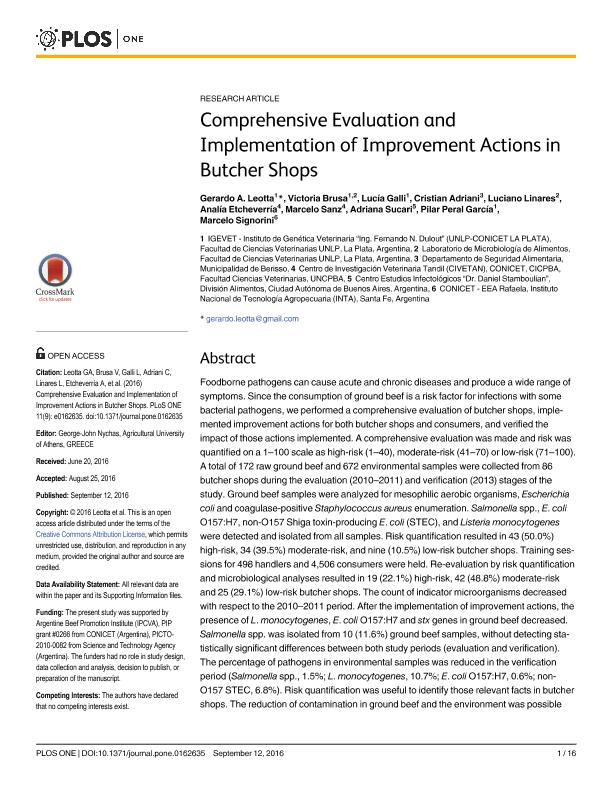Mostrar el registro sencillo del ítem
dc.contributor.author
Leotta, Gerardo Anibal

dc.contributor.author
Brusa, Victoria

dc.contributor.author
Galli, Lucía

dc.contributor.author
Adriani, Cristian
dc.contributor.author
Linares, Luciano Hector

dc.contributor.author
Etcheverría, Analía Inés

dc.contributor.author
Sanz, Marcelo Eduardo

dc.contributor.author
Sucari, Adriana
dc.contributor.author
Peral Garcia, Pilar

dc.contributor.author
Signorini Porchietto, Marcelo Lisandro

dc.date.available
2018-06-13T18:37:43Z
dc.date.issued
2016-09
dc.identifier.citation
Leotta, Gerardo Anibal; Brusa, Victoria; Galli, Lucía; Adriani, Cristian; Linares, Luciano Hector; et al.; Comprehensive Evaluation and Implementation of Improvement Actions in Butcher Shops; Public Library of Science; Plos One; 11; 9; 9-2016; 1-16; e0162635
dc.identifier.issn
1932-6203
dc.identifier.uri
http://hdl.handle.net/11336/48574
dc.description.abstract
Foodborne pathogens can cause acute and chronic diseases and produce a wide range of symptoms. Since the consumption of ground beef is a risk factor for infections with some bacterial pathogens, we performed a comprehensive evaluation of butcher shops, implemented improvement actions for both butcher shops and consumers, and verified the impact of those actions implemented. A comprehensive evaluation was made and risk was quantified on a 1–100 scale as high-risk (1–40), moderate-risk (41–70) or low-risk (71–100). A total of 172 raw ground beef and 672 environmental samples were collected from 86 butcher shops during the evaluation (2010–2011) and verification (2013) stages of the study. Ground beef samples were analyzed for mesophilic aerobic organisms, Escherichia coli and coagulase-positive Staphylococcus aureus enumeration. Salmonella spp., E. coli O157:H7, non-O157 Shiga toxin-producing E. coli (STEC), and Listeria monocytogenes were detected and isolated from all samples. Risk quantification resulted in 43 (50.0%) high-risk, 34 (39.5%) moderate-risk, and nine (10.5%) low-risk butcher shops. Training sessions for 498 handlers and 4,506 consumers were held. Re-evaluation by risk quantification and microbiological analyses resulted in 19 (22.1%) high-risk, 42 (48.8%) moderate-risk and 25 (29.1%) low-risk butcher shops. The count of indicator microorganisms decreased with respect to the 2010–2011 period. After the implementation of improvement actions, the presence of L. monocytogenes, E. coli O157:H7 and stx genes in ground beef decreased. Salmonella spp. was isolated from 10 (11.6%) ground beef samples, without detecting statistically significant differences between both study periods (evaluation and verification). The percentage of pathogens in environmental samples was reduced in the verification period (Salmonella spp., 1.5%; L. monocytogenes, 10.7%; E. coli O157:H7, 0.6%; non-O157 STEC, 6.8%). Risk quantification was useful to identify those relevant facts in butcher shops. The reduction of contamination in ground beef and the environment was possible after training handlers based on the problems identified in their own butcher shops. Our results confirm the feasibility of implementing a comprehensive risk management program in butcher shops, and the importance of information campaigns targeting consumers. Further collaborative efforts would be necessary to improve foodstuffs safety at retail level and at home.
dc.format
application/pdf
dc.language.iso
eng
dc.publisher
Public Library of Science

dc.rights
info:eu-repo/semantics/openAccess
dc.rights.uri
https://creativecommons.org/licenses/by-nc-sa/2.5/ar/
dc.subject
Stec
dc.subject
Salmonella
dc.subject
Listeria
dc.subject
Butcheries
dc.subject.classification
Otras Ciencias Veterinarias

dc.subject.classification
Ciencias Veterinarias

dc.subject.classification
CIENCIAS AGRÍCOLAS

dc.title
Comprehensive Evaluation and Implementation of Improvement Actions in Butcher Shops
dc.type
info:eu-repo/semantics/article
dc.type
info:ar-repo/semantics/artículo
dc.type
info:eu-repo/semantics/publishedVersion
dc.date.updated
2018-06-12T13:32:02Z
dc.journal.volume
11
dc.journal.number
9
dc.journal.pagination
1-16; e0162635
dc.journal.pais
Estados Unidos

dc.journal.ciudad
San Francisco
dc.description.fil
Fil: Leotta, Gerardo Anibal. Consejo Nacional de Investigaciones Científicas y Técnicas. Centro Científico Tecnológico CONICET- La Plata. Instituto de Genética Veterinaria "Ing. Fernando Noel Dulout". Universidad Nacional de La Plata. Facultad de Ciencias Veterinarias. Instituto de Genética Veterinaria; Argentina
dc.description.fil
Fil: Brusa, Victoria. Consejo Nacional de Investigaciones Científicas y Técnicas. Centro Científico Tecnológico CONICET- La Plata. Instituto de Genética Veterinaria "Ing. Fernando Noel Dulout". Universidad Nacional de La Plata. Facultad de Ciencias Veterinarias. Instituto de Genética Veterinaria; Argentina
dc.description.fil
Fil: Galli, Lucía. Consejo Nacional de Investigaciones Científicas y Técnicas. Centro Científico Tecnológico CONICET- La Plata. Instituto de Genética Veterinaria "Ing. Fernando Noel Dulout". Universidad Nacional de La Plata. Facultad de Ciencias Veterinarias. Instituto de Genética Veterinaria; Argentina
dc.description.fil
Fil: Adriani, Cristian. Municipio de Berisso. Departamento de Seguridad Alimentaria; Argentina
dc.description.fil
Fil: Linares, Luciano Hector. Universidad Nacional de La Plata. Facultad de Ciencias Veterinarias; Argentina
dc.description.fil
Fil: Etcheverría, Analía Inés. Consejo Nacional de Investigaciones Científicas y Técnicas. Centro Científico Tecnológico Conicet - Tandil. Centro de Investigación Veterinaria de Tandil. Universidad Nacional del Centro de la Provincia de Buenos Aires. Centro de Investigación Veterinaria de Tandil. Provincia de Buenos Aires. Gobernación. Comision de Investigaciones Científicas. Centro de Investigación Veterinaria de Tandil; Argentina
dc.description.fil
Fil: Sanz, Marcelo Eduardo. Consejo Nacional de Investigaciones Científicas y Técnicas. Centro Científico Tecnológico Conicet - Tandil. Centro de Investigación Veterinaria de Tandil. Universidad Nacional del Centro de la Provincia de Buenos Aires. Centro de Investigación Veterinaria de Tandil. Provincia de Buenos Aires. Gobernación. Comision de Investigaciones Científicas. Centro de Investigación Veterinaria de Tandil; Argentina
dc.description.fil
Fil: Sucari, Adriana. Centro Estudios Infectológicos “Dr. Daniel Stamboulian”; Argentina
dc.description.fil
Fil: Peral Garcia, Pilar. Consejo Nacional de Investigaciones Científicas y Técnicas. Centro Científico Tecnológico CONICET- La Plata. Instituto de Genética Veterinaria "Ing. Fernando Noel Dulout". Universidad Nacional de La Plata. Facultad de Ciencias Veterinarias. Instituto de Genética Veterinaria; Argentina
dc.description.fil
Fil: Signorini Porchietto, Marcelo Lisandro. Instituto Nacional de Tecnología Agropecuaria. Centro Regional Santa Fe. Estación Experimental Agropecuaria Rafaela; Argentina. Consejo Nacional de Investigaciones Científicas y Técnicas; Argentina
dc.journal.title
Plos One

dc.relation.alternativeid
info:eu-repo/semantics/altIdentifier/url/https://www.ncbi.nlm.nih.gov/pmc/articles/PMC5019392/
dc.relation.alternativeid
info:eu-repo/semantics/altIdentifier/url/https://journals.plos.org/plosone/article?id=10.1371/journal.pone.0162635
dc.relation.alternativeid
info:eu-repo/semantics/altIdentifier/doi/https://dx.doi.org/10.1371/journal.pone.0162635
Archivos asociados
